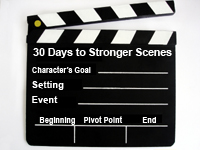Why Plot with Scenes?

Join us on Facebook for a discussion of scenes.
Once you have a scene list, you need to decide which scenes to actually write. I’ve found it helpful to think about scenes as Zooms, or places where I want the reader to stop and spend some time noticing details.
Scenes are those sections which will embody the tone, theme, characters, action and emotion of your story. Looking at a scene list, you’ll have three choices: omit a scene, ell the scene briefly with narrative summary, or fully develop a scene.
Omit Scenes:
Omit any scene in which there is no conflict or conflict that doesn’t contribute to your theme. Also leave out any scenes in which main character can’t be present for the conflict, or isn’t directly involved in the conflict. You’re looking for drama! Conflict and tension.
Summarize Scenes: Scenes which are essential to the story, but lack drama for whatever reason. These will be minor scenes which are needed for the story to make sense, the time line to work, or the story’s logic to work, yet lack drama and tension.
Fully Develop Scenes. When a scene directly features and/or impacts the main character, it’s a potential scene for full treatment. Stories live or die by the choice of scenes to use in telling the story. Each author will choose slightly different scenes and will develop them in different ways, that’s the beauty of reading fiction even if it’s a plot with which we are familiar. It’s why there can be hundreds of Cinderella stories across the world.
It’s at this crucial point, your storytelling sensibilities will come to life. What scenes will you Zoom in on where will you omit or summarize a scene? It’s your choice.
Featured Today in Fiction Notes Stores
 November discount: 10% off orders of $30 or more. Use discount code: scene.
November discount: 10% off orders of $30 or more. Use discount code: scene.
 |  It's Here. |



